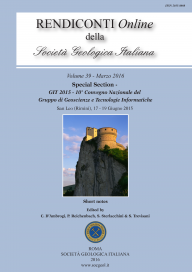
Geotourism and Economy in Irpinia (Campania, Italy)
Antonio Di Lisio (a,b), Michele Sisto (a), Cosimo Iscaro (a) & Filippo Russo (a)
(a) Dipartimento di Scienze e Tecnologie, Università degli Studi del Sannio, Via dei Mulini, 59/A, 82100 Benevento, Italy. E-mails: filrusso@unisannio.it; micsisto@unisannio.it;
cosimo804@yahoo.it
(b) E-mail corresponding author: adilisio@libero.it
Volume: 39/2016
Pages: 72-75
Abstract
The Landscape of Irpinia (Campania, Italy) is one of the few Italian landscapes which, to a large extent, has been preserved from the "Great Transformation" which started after World War II. Both the natural architectures and the environmental specificities of this area testify an almost perfect maintenance of the local landscape resources, these latter resulting from the peculiar combination of geological and geomorphological features, on which the signs of civilizations superimposed are currently clearly recognizable. The Irpinian landscape could potentially show its high cultural value, also of didactic interest, in the framework of a high-quality tourism, based on winter-sports activities, naturalistic trekking, tours of archaeological sites and monuments, tasting local gastronomic products. Many Irpinian areas could represent also a link between the Human and Earth Sciences, as the geological processes always deeply interacted with the historical development of the local populations. Certainly, geotourism could create and/or increase interest around these sites of high cultural and naturalistic value, which were visited and described by learned travellers of the Grand Tour. In this way Geotourism could represent a new perspective of sustainable development for these areas, where a weak economy primarily based on agriculture didn't take advantage from the industrialization. To exploit the touristic resources, described in the first part of this paper, new abilities are required in Earth and Human Sciences to understand any mutual interaction. To the knowledge of Authors is necessary to expand a tourism with a salient, more and more identifiable cultural connotation.
Keywords
Get Full Text